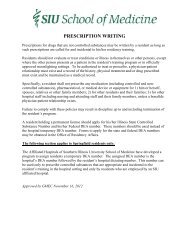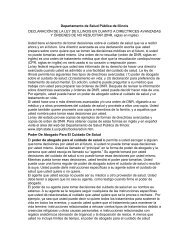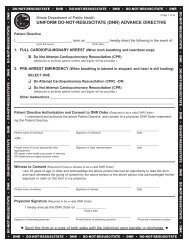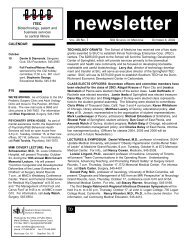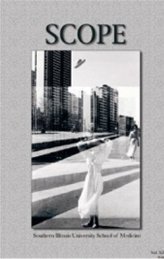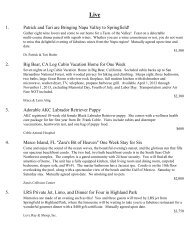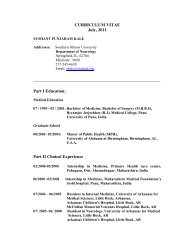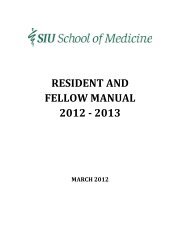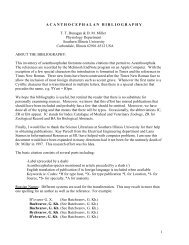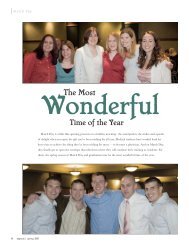Ch. 54 – Biliary System
Ch. 54 – Biliary System
Ch. 54 – Biliary System
Create successful ePaper yourself
Turn your PDF publications into a flip-book with our unique Google optimized e-Paper software.
An adequate incision permitting full visualization is<br />
necessary for a good biliary-enteric anastomosis. A right<br />
subcostal incision extended to either the midline (hockey<br />
stick) or the left (chevron incision) is usually necessary.<br />
The liver should be completely freed from the diaphragm,<br />
and adhesions from previous operations should be taken<br />
down to facilitate creation of a Roux-en-Y jejunal limb if<br />
necessary (Fig. <strong>54</strong>-23). The Hepp-Couinaud approach to<br />
bile duct reconstruction is the best option in most circumstances.<br />
This technique requires dissection of the<br />
hilar plate to expose the left hepatic duct and allow for<br />
a side-to-side anastomosis of the left hepatic duct to the<br />
Roux-en-Y jejunal limb. The use of a Roux-en-Y jejunal<br />
limb is favored over a direct choledochoduodenostomy<br />
or choledochojejunostomy because it also allows for the<br />
creation of an “access loop” of the proximal portion of<br />
the Roux-en-Y limb for future interventional radiologic<br />
access.<br />
Interventional Radiologic and Endoscopic Techniques<br />
Interventional radiologic techniques are useful in patients<br />
with bile duct injuries, leaks, or postoperative strictures.<br />
These techniques allow percutaneous drainage of abdominal<br />
fl uid collections, preoperative identifi cation of the<br />
ductal anatomy through percutaneous transhepatic cholangiography,<br />
and stricture dilation with or without placement<br />
of palliative stents for bile drainage in the patient<br />
whose overall physiologic status precludes a major operation.<br />
Percutaneous transhepatic dilation can be employed<br />
in patients with intrahepatic ductal disease and in patients<br />
in whom ERCP is not possible. It is often used as an<br />
adjunct to operative repair in order to assist with identifi<br />
cation of the proximal biliary tree for reconstruction and<br />
for the dilation of anastomotic strictures.<br />
The success rate of percutaneous transhepatic dilation<br />
is reported between 50% and 70%. Patients with anastomotic<br />
strictures (including biliary-enteric anastomotic<br />
strictures) have the highest success rates. A study of 89<br />
patients treated for major bile duct injuries following<br />
laparoscopic cholecystectomy showed that by a mean<br />
follow-up of 27 months, percutaneous dilation yielded<br />
only a 64% success rate in ischemic strictures versus 92%<br />
at 33.4 months in patients with biliary-enteric anastomotic<br />
strictures. 33 In addition, although mortality following percutaneous<br />
dilation is low, complication rates are reported<br />
as high as 35%, and complications consist mainly of<br />
hemobilia, cholangitis, and bile leaks. These procedures<br />
often require multiple sessions of dilation to achieve<br />
long-term success rates.<br />
When reported from large-volume centers, endoscopic<br />
and percutaneous methods of dilation have equivalent<br />
effi cacy. Endoscopic dilation of benign extrahepatic<br />
biliary strictures is also a useful adjunctive option in<br />
patents with a dominant extrahepatic stricture causing<br />
clinical symptoms. In general, treatment of biliary strictures<br />
with this technique, as with interventional radiologic<br />
methods, requires multiple sessions of dilations, and<br />
nonischemic strictures (anastomotic strictures) respond<br />
best. Endoscopic dilation also has a low mortality rate,<br />
but it has a signifi cant morbidity rate. The more common<br />
complications following endoscopic biliary interventions<br />
<strong>Ch</strong>apter <strong>54</strong> <strong>Biliary</strong> <strong>System</strong> 1571<br />
Figure <strong>54</strong>-23 End-to-side biliary reconstruction with Roux-en-Y<br />
hepaticojejunostomy. Note than anterior row of PDS sutures is<br />
placed fi rst to elevate anterior wall of bile duct and facilitate<br />
exposure.<br />
include hemobilia, bile leak, pancreatitis, and cholangitis.<br />
In a study of 101 patients with benign biliary strictures,<br />
66 patients were treated endoscopically, with a reported<br />
re-stricture rate of 18% at 3 months and a complication<br />
rate of 35%. 34 Although endoscopic and interventional<br />
radiologic procedures are not ideal long-term treatments<br />
for unresponsive biliary strictures, endoscopic stenting<br />
and drainage is a successful treatment option for cystic<br />
duct leak or small common bile duct leaks following<br />
laparoscopic cholecystectomy.<br />
Careful long-term follow-up of patients with biliary<br />
strictures treated with percutaneous or endoscopic dilation<br />
methods is required because ischemic biliary strictures<br />
will not respond permanently to dilation. Early<br />
retreatment (through repeat dilation or biliary-enteric reconstruction)<br />
of postdilation recurrent strictures is essential<br />
to prevent secondary biliary cirrhosis. The risk for additive<br />
morbidity from the required repeat sessions and the<br />
risk for late stricture recurrence should be considered and<br />
discussed with patients when treatment options for<br />
benign biliary strictures are being considered.<br />
Outcomes<br />
Acceptable long-term results can be achieved in most<br />
patients undergoing operative repair of bile duct injuries.<br />
More than 90% of patients are free of jaundice and cholangitis<br />
after operative repair of a laparoscopic bile duct<br />
injury. 28 The best results are obtained when the injury is<br />
recognized during the cholecystectomy and repaired by<br />
an experienced biliary surgeon. Postoperative injuries<br />
identifi ed in the presence of concomitant biliary leak<br />
should be repaired once the biliary leak has subsided<br />
and tissue planes are less infl amed, usually 6 weeks after<br />
initial laparoscopic cholecystectomy. Complications of



